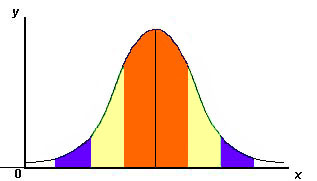You are here:
- Home »
- Using evidence for learning »
- Working with data »
- Mean, median, and standard deviation
Mean, median, and standard deviation
Mean and median
The mean and the median are both measures of central tendency that give an indication of the average value of a distribution of figures.
The mean is the average of a group of scores. The scores added up and divided by the number of scores. The mean is sensitive to extreme scores when population samples are small. For example, for a class of 20 students, if there were two students who scored well above the others, the mean will be skewed higher than the rest of the scores might indicate. Means are better used with larger sample sizes.
The median is the point at which half the scores are above and half the scores are below. Medians are less sensitive to extreme scores and are probably a better indicator generally of where the middle of the class is achieving, especially for smaller sample sizes.
The larger the population sample (number of scores) the closer mean and median become. In fact, in a perfect bell curve, the mean and median are identical.
Standard deviation
Standard deviation (SD) is a widely used measurement of variability used in statistics. It shows how much variation there is from the average (mean). A low SD indicates that the data points tend to be close to the mean, whereas a high SD indicates that the data are spread out over a large range of values.

One SD away from the mean in either direction on the horizontal axis (the orange area on the graph) accounts for around 68 percent of the people in this group. Two SDs away from the mean (the orange and beige areas) account for roughly 95 percent of the people. And three SDs (the orange, beige and blue areas) account for about 99 percent of the people.
If this curve were flatter and more spread out, the SD would have to be larger in order to account for those 68 percent or so of the people. The SD can tell you how spread out the examples in a set are from the mean.
So if you are comparing test scores for different classes or cohorts, the SD will tell you how diverse those scores are.
For example, if you were to calculate the SD of scores from a class of students of similar ability, you would expect it to be low, because the scores would all be close to the mean. On the other hand, you would expect the SD of scores from a mixed-ability class to be higher. If these calculations did not conform to expectations, you would want to look more closely at the data to check for inaccuracies.
Standard deviations – interactive illustration
The following interactive illustrates standard deviations for two very different classes. One class has a standard deviation of 10, while the other a standard deviation of 20. Click on the buttons to see the effect this has on the spread of results.
Large/Small Standard Deviation
Please choose which graph to show.
Class A: Median = 50, StdDev = 20
68% of the students lie within one standard deviation, that is approx
2/3 of all students obtained a mark between 30 and 70%. 95% of the
students lie withing 2 standard deviations and therefore obtained
marks between 10 and 90%.

